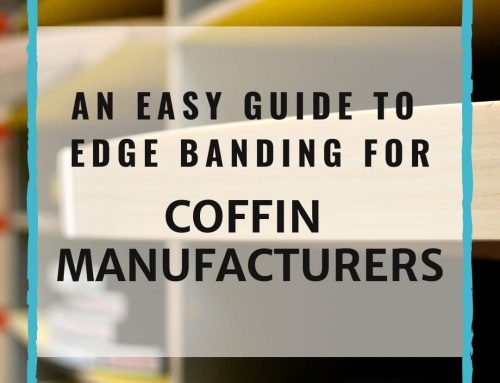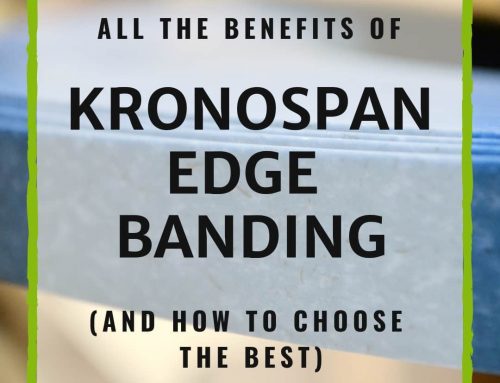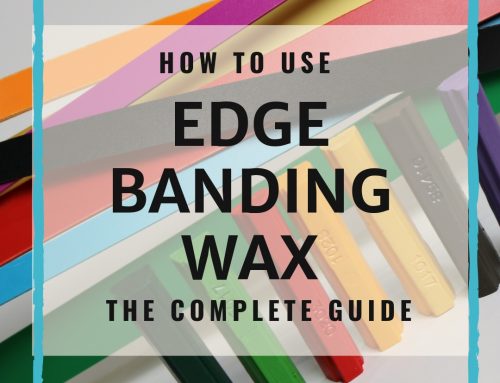Like many woodworking or furniture products, edge banding is applied with glue. Depending on your project, it will likely be a hot melt glue.
Any time you’re working with glue, things can get a little messy. No matter how experienced you are at applying edge banding or what machinery you are working with, glue can find its way onto places it’s not supposed to be. Smudges, stringing, excess glue at the bondline – all these things can leave your edges looking untidy and ruin the overall effect of your project.
When you have spent your time and energy designing and creating your project – whether that’s a piece of furniture, a kitchen or a whole public environment concept – you want to see the finished project as pristine as you imagined it.
There are a number of techniques you can use to remove unwanted glue and a wide range of specialist products. So, read on for our guide to how to easily remove edge banding adhesive…
Use The Right Removal Product For Your Edge Banding Adhesive…
How best to remove the unwanted glue depends on the type of glue you are using. Most edge banding is applied with a hot melt glue, usually either EVA (Ethylene Vinyl Acetate) and PUR (Polyurethane). You can also use contact adhesive.
These are pretty tough adhesives, so you’re not going to be able to remove them without a specialist solution or something pretty strong. You definitely don’t want to damage your edge banding or boards in the process of glue removal, so always go for a product that’s designed to remove the specific glue you are using.
If you need to remove adhesive from your edge banding equipment such as glue tanks and hoses, there are also specialist products you can get for those jobs to be sure your equipment is in the best condition whenever you need it.
EVA adhesive can be repeatedly remelted, a useful quality if you need to remove EVA residue left after stripping off old edge banding. You can gradually reheat it until the glue softens enough to be gently scraped off.
Removing Hot Melt Glue With Alcohol…
You can use denatured alcohol, or ethanol/methylated spirit, to remove any hot melt glue from laminate or melamine boards. Denatured alcohol is simply ethanol that has additives to make it unsuitable for consumption – such as a bad smell/taste or toxins. Always read the label and wear protective gloves and glasses in case of irritation to the skin or eyes when using alcohol. Also, make sure your working area is well ventilated.
Whether the glue is wet or dry, dip a cotton bud or clean cloth into the alcohol and gently dab over the area of unwanted glue. Let the alcohol work for a moment and then wipe it away.
For glue spots you can also try isopropyl or rubbing alcohol. Rub a little around the edges of the glue spot you want to remove and let it work for a moment. The glue spot should peel right off.
Denatured alcohol is a pretty strong solvent, but used correctly it shouldn’t damage your material. Don’t let it sit on your boards or edging for too long however, and wipe over with a damp cloth when finished to remove all traces of the alcohol.
If in doubt, test the alcohol on an inconspicuous area of your edge banding or boards first to be sure it won’t damage the surface of the material you’re working with.
This technique should be fine used on ABS or wood veneer edge banding, however you should never use alcohol on Acrylic edge banding as it will cause it to ‘craze’. Speciality products are available for cleaning Acrylic plastics.
Removing Contact Adhesive From Edge Banding…
You should also be able to remove contact adhesive/cement using this denatured alcohol method. Contact adhesive is rubber-based – creating a flexible bond, and is ‘moisture cure’, meaning it hardens as the moisture evaporates from it. It forms an instant bond, even between two hard-to-bond materials.
Unlike other glues, contact adhesive never fully cures; but remains sticky. This means it can be softened with heat even after it has bonded. This is good to know if you need to completely remove your edge banding that has been applied with contact adhesive, and start again. You can apply heat to the edge banding and then peel away. Remove any residue with a solvent as above and by gently scraping if needed.
How To Remove Spills Of Edge Banding Adhesive
With the best will in the world, accidents happen. If you find you’ve completed a project or item and there is extra edge banding adhesive that has been spilled on your surfaces it can be a pain to get off. If your adhesive has landed in a ball, you may find it can be ‘pinged’ off by gently levering up one end and tapping it.
If, however, your adhesive has spread across your surface in a layer, it can be trickier to remove. The best time to do it is immediately after it’s happened, while still wet. Gently wiping it away before it dries is a lot easier than trying to remove it after the fact.
But if you don’t notice in time, or are unable to get to it, there are a couple of easy ways to remove it without damaging your surface. The first is to soak a cloth or rag in white vinegar and thoroughly wipe the area covered in excess glue. Lever it to soak for a while (overnight if possible) then wipe it off. You can use a single edge razor if needed, like a cabinet scraper. If vinegar isn’t strong enough to remove it the other option is photographic Acetic Acid, which can be used in the same way but is more concentrated than vinegar.
What Not To Use To Remove Edge Banding Adhesive…
There are some things you should not use to remove glue, that could damage your boards or edge banding in the process. This includes acids, bleach or abrasive cleaning products or cloths. Always read the labels of products to be sure it is suitable for the material you are working with.
Types Of Adhesive Remover/Cleaning Solutions…
There is a large choice of specialist edge banding adhesive cleaners and removers on the market. These are designed for all those little glue mishaps, cleaning old glue when replacing edge banding and for making sure your application equipment stays in top working condition. These days, there is also a choice of organic or non-toxic glue cleaning products. You can find our range of edge banding adhesive cleaners and removers over in our shop.
Stay Calm And Clean Up…
When glue mishaps happen, don’t panic! There is always a solution that will allow you to clean up and carry on. It is worth doing your research on the best edge banding adhesive removers and cleaners and trying out a couple to see which work best for you and your equipment. Then, be sure to keep a good stock of it so you are never caught out.
Try out your technique on scrap boards/edging so you can perfect your method of removal without risking the finish of your projects.
If you’re still not sure how to go about cleaning or removing glue from projects and equipment, or just need some further advice, get in touch with our friendly team of experts. There’s no sticky situation that we can’t help you out of (glue related that is!)





